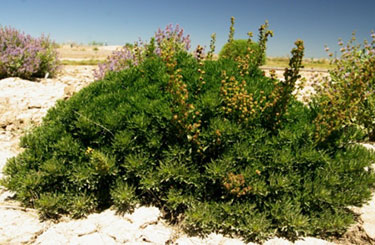Michaux’s Sage in the Landscape

Stephen Love, University of Idaho
Scientfic Name: Artemisia michauxianaCommon Name: Michaux’s Sage, Michaux’s Wormwood, Lemon Sagewort, Michally Sagewort
Description: Michaux’s sage is a long-lived, mounding perennial - more valuable for its attractive foliage than for color provided by the inconspicuous flowers. Mature plants grow to 15 or more inches tall and up to 3 feet across. Stems are numerous and spreading. In the best forms of the species, the foliage creates a dense, attractive mound. Inferior forms can be much looser in structure and can have aggressive rhizomatous habit. Leaves are ferny and have a rich, unusual emerald green color. Stems and leaves are almost hairless. Flowers grow on loose spikes, are relatively small, and yellow and green in color and fade to dark brown as they mature. Plants are herbaceous, each winter dying back to underground rhizomes and developing sprouts from beneath the ground each spring. Due to its neutral color and short-mounding habit, Michaux’s sage has considerable versatility in the garden, providing the roles of specimen, complementary companion, repetitive element, or textural element in any bed or border.
Native Habitat: Artemisia michauxiana inhabits subalpine and alpine sites, growing primarily on talus slopes and in drainage ravines. The species can be found in all mountainous western states except Arizona and New Mexico. This species grows primarily at elevations ranging from 4,800 to 9,800 feet, although it can grow at lower elevations in the coastal ranges.
Cultural Requirement
Soil: Michaux’s sage tolerates a wide range of soil types, except saturated heavy clay. Plants may require the addition of low amounts of nitrogen fertilizer to maintain outstanding foliage appearance.
Moisture Tolerance: Maintains good vigor under moderately dry to moderately moist conditions. Requires some supplemental water in areas with less than 10 inches of annual precipitation.
Sun/Shade/Preference: Prefers full sun but tolerates part shade.
Transplanting: Tolerates pot culture and transplants well from pot to pot and pot to garden. Potted plants grow at a moderately fast pace and typically bloom in the pots or in the garden during the first season.
Propagation: Best grown from seeds, although plants can be easily propagated from root cuttings. Seeds require no stratification or other pretreatments and consistently germinate at relatively high rates. Young seedlings grow at a moderate rate. Plants consistently bloom in the pot, although the presence of flowers is not necessarily advantageous to increase marketability. Pots up to 1-gallon size are appropriate for production of Michaux’s sage.
Maintenance (pruning, fertilization, deadheading, division, irrigation, etc): Michaux’s sage is a relatively carefree species. Dead stems from the previous season are persistent and require removal in early spring. Supplemental irrigation is recommended for the driest of regions of the Intermountain West. Fertilizer containing nitrogen is recommended if plants show poor vigor or light color.
Insect, disease, or other problems: Michaux’s sage under sprinkler irrigation can be infected late in the season with a fungal disease that turns the foliage dark. Manage the disease by avoiding sprinkler irrigation or treating foliage with a fungicide as soon as the first symptoms appear.
Landscape Value
Use in the Landscape: Neutral color, mound form, and season-long attractiveness allows Michaux’s sage to contribute significantly to a water-conserving landscape. This species can be grouped to create a point of interest, used to complement almost any specimen plant, or used to create repetition or line in the garden. As a companion plant, this species can be planted among either shorter or taller perennials for multiple effects. It can be used to create structure in almost any type of planting.
Weediness/Invasive Potential: Michaux’s sage is not weedy from seed. Some forms of the species can be aggressively rhizomatous. Purchase of spreading forms should be avoided to prevent plants from crowding out neighboring species.
Foliage: Plants of Michaux’s sage produce numerous stems, branched from the base. The overall effect is a dense mound. Leaves are dark emerald green, hairless, and bipinnate, giving the foliage a somewhat fern-like appearance. The foliage is very attractive and is the horticulturally valuable part of the plants.
Flower: Flowers are composite, inconspicuous, and held in loose spikes. Flower heads are very small and made up of multiple disk flowers. Color is greenish-purple with yellow centers. As flowers age, they turn dark brown. The flowers are not showy but the spikes do add interest to the plants.
Timing: June-August.
Fruit: Each flower head produces several fruits consisting of hairless achenes (seeds).
Form: Symmetrical loose moods.
Texture: Fine.
Ultimate Size: Plants are typically about 15 inches tall and continuously expand from short rhizomes and over a period of 2 or 3 years reach a spread to 3 feet.
Rate of Growth: Michaux’s sage grows at a moderately fast rate. Plants typically bloom during their first season in the garden.
Suggested Plant Partners: Michaux’s sage can be successfully placed with any species having similar water requirements. This species complements almost any native ornamental grass species, including Idaho fescue (Festuca idahoensis), big bluegrass (Poa secunda), blue grama (Bouteloua gracilis), sideoats grama (Bouteloua curtipendula), alkali sacaton (Sporobolus airoides), big sacaton (Sporobolus wrightii), and little bluestem (Schizachyrium scoparium). This species can also be placed with numerous tall and short perennials, such as littlecup penstemon (Penstemon sepalulus), Rocky Mountain penstemon (Penstemon strictus), pineleaf penstemon (Penstemon pinifolius), shtubby penstemon (Penstemon fruticosus), bubblegum mint (Agastache cana), sulphurflower buckwheat (Eriogonum umbellatum), arrowleaf buckwheat (Eriogonum compositum), white checkermallow (Sidalcea candida), and western coneflower (Rudbeckia occidentalis).
Availability: Occasionally available for local sale as potted plants from native plant nurseries. Seed can be purchased from native plant seed suppliers.
Cultivars: No cultivars available.
References:

